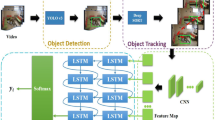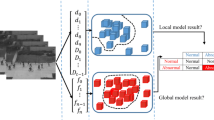Abstract
Pedestrian detection, tracking, and suspicious activity recognition have grown increasingly significant in computer vision applications in recent years as security threats have increased. Continuous monitoring of private and public areas in high-density areas is very difficult, so active video surveillance that can track pedestrian behavior in real time is required. We present an innovative and robust deep learning system as well as a unique pedestrian dataset that includes student behavior like as test cheating, laboratory equipment theft, student disputes, and danger situations in institutions. It is the first of its kind to provide pedestrians with a unified and stable ID annotation. Again, we also presented a comparative analysis of result achieved by the recent deep learning approach of pedestrian detection, tracking, and suspicious activity recognition methods on a recent benchmark dataset. Our investigation will provide new research directions in vision-based surveillance for practitioners and research scholars.
Access this chapter
Tax calculation will be finalised at checkout
Purchases are for personal use only
Similar content being viewed by others
References
Ahmed, M., Jahangir, M., & Afzal, H. (2015). Using crowd-source based features from social media and conventional features to predict the movies popularity. In IEEE International Conference on Smart Cities, Social Communication and Sustained Communication, China (pp. 273–278).
Bergmann, P., Meinhardt, T., & Taixe, L. (2019). Tracking without bells and whistles. In IEEE ICCV, Seoul, Korea (pp. 1–16).
Dollar, P., Wojek, C., Schiele, B., & Perona, P. (2012). Pedestrian detection: An evaluation of the state of the art. IEEE TPAMI, 34(4), 743–761.
Samsi, S., Weiss, M. L., Bestor, D., Li, D., Jones, M., Reuther, A., Edelman, D., Arcand, W., & Byun, C. (2021). The MIT supercloud dataset. Cornell Journal of Distributed, Parallel, and Cluster Computing, 2108(02037).
Silberstein, S., Levi, D., Kogan, V., & Gazit, R. (2014). Vision-based pedestrian detection for rear-view cameras. In IEEE Intelligent Vehicles Symposium Proceedings, Dearborn, MI, USA (pp. 853–860).
Alom, M. Z., & Taha, T. M. (2017). Robust multi-view pedestrian tracking using neural networks. In IEEE National Aerospace and Electronics Conference (NAECON), Dayton, OH, USA (pp. 17–22).
Zhang, X., Park, S., Beeler, T., Bradley, D., Tang, S., & Hilliges, O. (2020). ETH-XGaze: A large scale dataset for gaze estimation under extreme head pose and gaze variation. In ECCV. Lecture Notes in Computer Science (Vol. 12350). Springer.
Wojek, C., Walk, S., & Schiele, B. (2009). IEEE CVPR, Miami, Florida, USA.
Nguyen, T., Kim, S., & Na, I. (2013). Fast pedestrian detection using histogram of oriented gradients and principal components analysis. International Journal of Contents.
Everingham, M., Van Gool, L., & Williams, C. K. I. (2010). The Pascal visual object classes (VOC) challenge. International Journal of Computer Vision, 88, 303–338.
Lin, T. Y., et al. (2014). Microsoft COCO: Common objects in context. In ECCV. Lecture Notes in Computer Science (Vol. 8693, pp. 740–755). Springer.
Nicolai, W., Bewley, A., & Dietrich, P. (2017). Simple online and real-time tracking with a deep association metric. In IEEE ICIP (pp. 3645–3649).
Dai, J., Li, Y., He, K., Sun, J., & FCN, R. (2016). Object detection via region-based fully convolutional networks. In CVPR (pp. 1–11).
Hajari, K., Gawande, U., & Golhar, Y. (2021). Deep learning approach to pedestrian detection: An evaluation of the state of the art. In Computing technologies and applications paving path towards society 5.0 (1st ed.,). Routledge and CRC Press, Taylor & Francis Group. ISBN:9780367763701.
Everingham, M., Eslami, S., Gool, V., Williams, C., & Winn, J. (2015). The PASCAL VOC challenge: A retrospective. IJCV, 111, 98–136.
Dalal, N., & Triggs, B. (2005). Histograms of oriented gradients for human detection. In IEEE Computer Society Conference on CVPR, San Diego, CA, USA (pp. 886–893).
Kaiming, H., Georgia, G., Dollar, P., & Girshick, R. (2020). Mask R-CNN. IEEE TPAMI, 42(2), 386–397.
Viola, P., & Jones, M. (2001). Rapid object detection using a boosted cascade of simple features. In Proceedings of the IEEE Computer Society Conference on CVPR, HI, USA (pp. I-I).
Felzenszwalb, P., Girshick, R., McAllester, D., & Ramanan, D. (2010). Object detection with discriminatively trained part-based models. TPAMI, 32(9), 1627–1645.
He, K., Gkioxari, G., Dollar, P., & Girshick, R. (2017). Mask R-CNN. In IEEE International Conference on Computer Vision, Venice, Italy (pp. 2980–2988).
Liu, W., Anguelov, D., Erhan, D., Szegedy, C., Reed, S., et al. (2016). SSD: Single shot multibox detector. In European Conference on Computer Vision (pp. 21–37). Springer.
Redmon, J., Girshick, R., & Farhadi, A. (2016). You only look once: Unified, real-time object detection. In IEEE Conference on CVPR, Las Vegas, NV, USA (pp. 779–788).
Bochinski, E., Senst, T., & Sikora, T. (2018). Extending IOU based multi-object tracking by visual information. In IEEE International Conference on Advanced Video and Signal Based Surveillance, Auckland, New Zealand.
Barnardin, K., & Stiefelhagen, R. (2008). Evaluating multiple object tracking performance: The CLEAR MOT metrics. EURASIP Journal on Image and Video Processing 246309.
Kratz, L., & Nishino, K. (2012). Tracking pedestrians using local spatio-temporal motion patterns in extremely crowded scenes. IEEE TPAMI, 34(5), 987–1002.
Wang, S., & Miao, Z. (2010). Anomaly detection in crowd scene. In 10th IEEE International Conference on Signal Processing, Beijing, China (pp. 1220–1223).
Wang, S., & Miao, Z. (2010). Anomaly detection in crowd scene using historical information. In IEEE International Symposium on Intelligent Signal Processing and Communication Systems, Chengdu, China (pp. 1–4).
Muhammad, G., Hossain, M., & Kumar, N. (2021). EEG-based pathology detection for home health monitoring. IEEE Journal on Selected Areas in Communications, 39(2), 603–610.
Muhammad, G., Alhamid, M. F., & Long, X. (2019). Computing and processing on the edge: Smart pathology detection for connected healthcare. IEEE Network, 33, 44–49.
He, K., Zhang, X., Ren, S., & Sun, J. (2015). Spatial pyramid pooling in deep convolutional networks for visual recognition. TPAMI, 37(9), 1904–1916.
Muhammad, N., Hussain, M., Muhammad, G., & Bebis, G. (2011). Copy-move forgery detection using dyadic wavelet transform. In Eighth International Conference on CGIV, Singapore (pp. 103–108).
Girshick, R., Donahue, J., Darrell, T., & Malik, J. (2014). Rich feature hierarchies for accurate object detection and semantic segmentation. In CVPR, Columbus, OH, USA (pp. 580–587).
Girshick, R. (2015). Fast R-CNN. In IEEE International Conference on CV, Santiago, Chile (pp. 1440–1448).
Ren, S., He, K., Girshick, R., & Sun, J. (2016). Faster R-CNN: Towards real-time object detection with region proposal networks. IEEE TPAMI, 39(6), 1137–1149.
Author information
Authors and Affiliations
Corresponding author
Editor information
Editors and Affiliations
Rights and permissions
Copyright information
© 2023 The Author(s), under exclusive license to Springer Nature Singapore Pte Ltd.
About this paper
Cite this paper
Hajari, K., Gawande, U., Golhar, Y. (2023). Deep Learning Approach for Pedestrian Detection, Tracking, and Suspicious Activity Recognition in Academic Environment. In: Rao, B.N.K., Balasubramanian, R., Wang, SJ., Nayak, R. (eds) Intelligent Computing and Applications. Smart Innovation, Systems and Technologies, vol 315. Springer, Singapore. https://doi.org/10.1007/978-981-19-4162-7_4
Download citation
DOI: https://doi.org/10.1007/978-981-19-4162-7_4
Published:
Publisher Name: Springer, Singapore
Print ISBN: 978-981-19-4161-0
Online ISBN: 978-981-19-4162-7
eBook Packages: Intelligent Technologies and RoboticsIntelligent Technologies and Robotics (R0)




